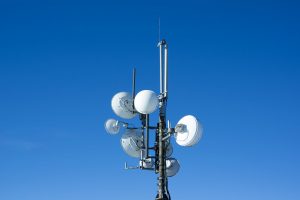Share This
Related Posts
Tags
Connection vs. Safety
By Erica Rascón on Jan 13, 2020 in News, Technology
To remain competitive, real estate providers face pressure to provide high speed internet. This pressure is felt throughout all property classes, from subsidized to luxury housing and commercial properties. Yet the Federal Communication Commission (FCC) is pushing back against signal boosters that pose a threat to public safety. The story is currently unfolding.
Here is what we know:
What is DAS?
Broadband signal boosters are proving to be a benefit for multi-tenant real estate owners and a danger to FCC operations. Distributed Antenna Systems (DAS) are one of the most common boosters. They are a network of separated antenna nodes connected to a single source that enhances wireless service within a geographic area or structure.
DAS helps to provide high-speed internet in areas where infrastructure is unfavorable for any number of reasons. Such fixed wireless technology has relatively little capital expenditure for ownership. No street-level digging is required. But like its pricier fiber optics competition, it offers a wide range of broadband transmission capabilities.
The challenges for real estate providers
Real estate providers turn to DAS to improve internet accessibility and performance for renters and tenants. Renters demand high speed internet, and the demand shows no signs of  slowing down. According to the National Multifamily Housing Council Resident Preference survey, 93% of renters rate reliable cellphone reception as a top interest. About 55% of respondents view high-speed internet as a necessity. Additionally, 74% of renters are interested in community Wi-Fi.
slowing down. According to the National Multifamily Housing Council Resident Preference survey, 93% of renters rate reliable cellphone reception as a top interest. About 55% of respondents view high-speed internet as a necessity. Additionally, 74% of renters are interested in community Wi-Fi.
In the multi-tenant commercial environment, broadband connectivity is among the top three features that tenants require, reports the Building Owners and Managers Association (BOMA) International and the Urban Land Institute. Broadband connectivity is standard in new construction, and more than 50 percent of existing construction is retrofitted in some way to accommodate the technology, states Craig Melby, CCIM, SIOR, president of ITRA/Palm Beach Corporate Real Estate in a CCIM market report.
While demand is high nationwide, coverage and quality are not standard nationwide. Rural and low-income areas face a lack of access or slow connectivity, which affects multiple facets of life ranging from education, employment, and commerce. DAS allows property owners of existing and new properties to offer more competitive connectivity options for occupants.
To address these issues, the NMHC submitted a letter signed by real estate owners, developers and managers from all segments of the industry, representing more than 1.5 million apartment homes and more than 2,000 commercial properties. The petition urges the FCC to refrain from additional regulations that affect broadband deployment, access, and provider partnerships in a multi-tenant environment.
The letter argues that those who oppose a respect for property rights and sharing of infrastructure buildout, maintenance and operation costs are “unfairly trying to profit from someone else’s investment—whether that be building wiring, Distributed Antenna Systems (DAS), rooftop space or some other portion of private property.”
Any additional interference, the letter asserts, will result in additional cost burdens for property owners. In turn, investment will slow down at a time when the entire real estate industry strives to address supply and affordability issues.
Furthermore, a separate letter sent during the summer regarding Amendment #36 addresses a caveat in the FCC’s plan to increase regulations: “Additional costs to owners would further limit broadband access in underserved areas such as low-income or mixed-income housing. The ordinance would arguably limit high-speed internet to high-end housing.” The NMHC letter concludes, “More regulation is not the answer.”
Commercial properties are not exempt from the conflict. Telecommunications technology costs are commonly passed to tenants, notes David J. Speady, senior advanced integration specialist for Staples Communications in Pompano Beach, Fla. When DAS is not in use, building owners commonly charge more for extra cable circuit brought up from the central location.
However, about 67% of tenants are unwilling to pay additional rent for Internet access. The 33% who are willing to pay expect costs to be lower than $1 per square foot. That data was released by Richard D. Baier, president of BOMA International during the 2019 State of the Industry address. “Tenants now expect high-speed access in a building as much as they expect [heating, ventilation, and air conditioning] and parking,” he said.
The challenges for the FCC
The connectivity battle has been raging within the FCC since the early 1990s. The Telecommunications Act of 1996 addressed a petition for the FCC and Congress to require free internet access for tenants in multiuse buildings. Real estate organizations fought back, saying mandatory internet violates property rights and limits the open market. The open market is functional and should not be regulated, real estate professionals rebutted, citing a BOMA survey of tenants that reveals building owners facilitated 98 percent of tenant requests for access to a particular service provider.
It’s how building owners are meeting demand that is also causing a problem. A solution like DAS keeps capital expenses low and adds value to properties, but it comes at a greater cost– safety.
In December 2019, the FCC issued a warning to property owners who use DAS or other wireless communications boosters. They were advised to gain consent of the provider whose signal is being transmitted. The warning, as well as related regulations, aim to limit signal boosters that can potentially interfere with public safety radio signals while first responders are on site.
No resolution in sight
To support property owners, the FCC issued guidance on required equipment registration, consent protocols and potential enforcement information. But many property owners, tenants, and service providers still do not feel the current measures protect their interests.
Get updates as the story unfolds on the NMHC Telecommunications advocacy page.
